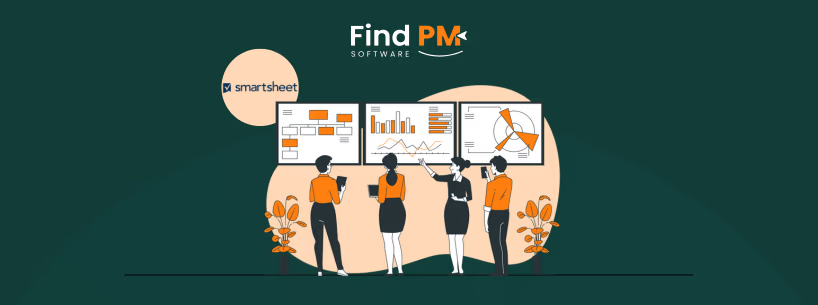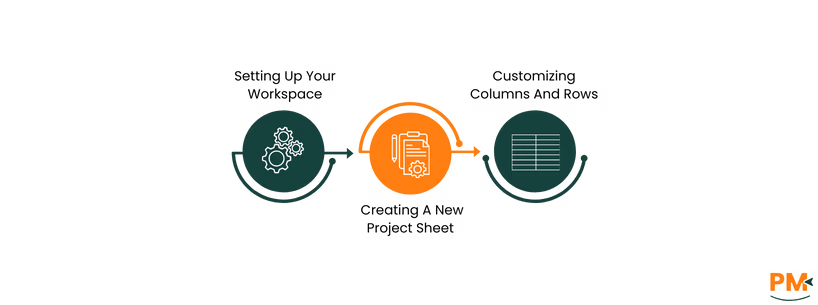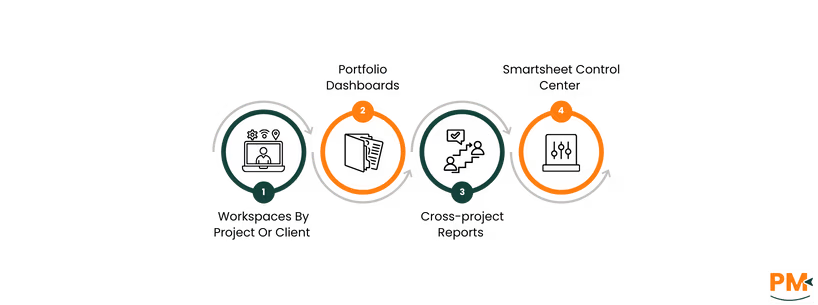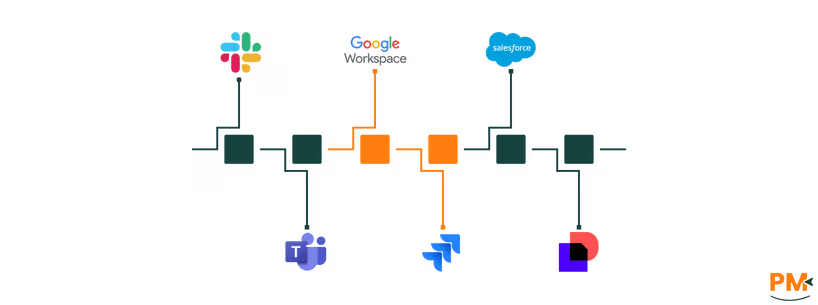
Smartsheet is a cloud-based project management platform that combines the flexibility of spreadsheets with the control and visibility of a purpose-built project tool. Its familiar interface makes it easy to adapt to. At the same time, its advanced features, like task automation, real-time dashboards, and multiple view types, enable teams to manage complex projects with accuracy and accountability.
Whether you're coordinating small teams or managing large-scale initiatives, Smartsheet project management software provides scalable solutions that enhance visibility, automate manual tasks, and facilitate seamless collaboration across departments.
This guide walks you through using Smartsheet for project management, from initial setup to advanced automation to help you manage projects efficiently and consistently.

To begin managing projects in Smartsheet, you'll need to set up your workspace, create your first sheet, and define how your project data will be tracked.
Setting Up Your Workspace
Begin by organizing your workspace, which is Smartsheet's top-level structure, where you group related projects and resources. To create a new workspace:
- Click the + Create button in the left panel
- Choose Workspace, assign it a name, and optionally add a description
- Organize folders by project phase, department, or client
- Set permissions per user or group; view-only, edit, or admin, depending on access needs
Proper workspace setup ensures secure access and centralized management of all associated sheets and dashboards.
Creating A New Project Sheet
You can build a sheet from scratch or start with a template:
- From scratch: Choose ‘Grid’ to begin entering tasks like you would in a spreadsheet
- From a template: Navigate to the Solution Center, browse categories like Project Management or IT, and select a layout that fits your workflow
Smartsheet supports multiple views:
- Grid View: Traditional spreadsheet format
- Gantt View: Visual timelines for scheduling
- Card View: Kanban-style task management
- Calendar View: Date-focused task tracking
Switching between views allows teams to visualize work the way that best suits them.
Customizing Columns And Rows
To tailor your sheet for project tracking:
- Add columns such as Task Name, Assigned To, Start Date, End Date, Status, and Priority
- Use Contact List columns to assign tasks to users
- Apply Dropdown columns for standardized status options (e. g. , Not Started, In Progress, Complete)
- Include Checkbox columns for approvals or QA indicators
- Format cells using conditional rules, for example, turn overdue tasks red automatically
This structure helps teams track deliverables, ownership, and timelines with clarity.
Smartsheet offers robust scheduling features that help you structure tasks and timelines effectively.
Utilizing Gantt Charts
Gantt view transforms your task list into a project timeline. To activate:
- Click the Gantt View icon
- Set Start and End Date columns if not already assigned
- Use the Predecessors column to link task dependencies
- Drag bars on the timeline to adjust durations or realign dependencies
This visualization helps stakeholders understand how tasks are connected and when bottlenecks can occur.
Setting Milestones And Deadlines
Milestones mark key project events, like kickoff meetings or product launches. To set one:
- Create a task row
- Set the duration to 0 days, and Smartsheet will treat it as a milestone
- Add a clear label and position it at the right phase in your Gantt chart
Pair milestones with deadline dates and reminders to ensure critical checkpoints aren't missed.
Smartsheet supports real-time collaboration, so teams stay aligned and updated as projects progress.
Sharing Sheets And Workspaces
Smartsheet simplifies team coordination by offering flexible sharing:
- Share individual sheets with teammates via email invite
- Grant workspace-level access for broader collaboration
- Choose permissions carefully: Viewer, Editor, or Admin
You can also publish read-only views of dashboards or sheets for clients or external stakeholders.
Commenting And Notifications
Smartsheet supports row-level comments, which are ideal for discussions on specific tasks:
- Click the speech bubble icon to leave a comment
- Use @mentions to notify teammates directly
- All comment history is preserved, making it easy to track discussions
Set up automated notifications to alert users when they’re assigned a task, when a status changes, or when deadlines are near.
Monitoring performance is essential to keeping your projects on track. Smartsheet provides visual tools and data summaries to give you actionable insights.
Using Dashboards And Reports
Smartsheet dashboards give visual insights across sheets. You can:
- Create widgets for KPIs, charts, metric rollups, and reminders
- Embed reports to surface filtered task lists or summaries
- Add logos, colors, or rich text for executive-ready presentations
Use reports to consolidate tasks across sheets. For example, a report might show all overdue tasks assigned to departments across different projects.
Setting Up Alerts And Reminders
To avoid delays, configure alerts like:
- Date-based reminders: Trigger reminders X days before a deadline
- Change-triggered alerts: Notify when status changes or a task is marked complete
- Approval workflows: Alert managers to review tasks or documents before moving forward
These automations keep everyone accountable without requiring manual follow-up.

When managing multiple projects simultaneously, Smartsheet helps maintain control and oversight through consolidated tracking and reporting.
- Workspaces by project or client: Organize multiple sheets under clearly labeled workspaces to separate teams, clients, or departments
- Portfolio dashboards: Roll up data from several sheets to give executives a unified view of KPIs, project health, or team workloads.
- Cross-project reports: Use filters to consolidate overdue tasks, budget variances, or status updates from multiple sheets into a single report
- Smartsheet Control Center (for Business/Enterprise plans): Standardize project creation, enforce consistency, and manage change across portfolios
This approach ensures visibility, coordination, and control, without duplicating efforts or losing sight of project dependencies.
Automation in Smartsheet reduces manual work and ensures consistency across projects.
Creating Automated Workflows
Automation reduces repetitive manual work. Here’s how to create one:
- Open a sheet, click Automation > Create a Workflow
- Choose a trigger, such as ‘When a row is added’ or ‘When a date is reached’
- Set conditions (e. g. , status = ‘Complete’)
- Define an action, like sending an alert, requesting approval, or updating a cell
This simplifies routine processes, such as notifying stakeholders, routing requests, or assigning task owners.
Integrating With Other Tools

Smartsheet integrates with over 40 platforms, including:
- Slack and Microsoft Teams: Receive Smartsheet updates in chat
- Google Workspace: Sync with Google Calendar or attach Drive files
- Jira: Sync issues with project tasks
- Salesforce: Link sales data to delivery schedules
- DocuSign: Automate document approvals
These integrations help unify communication and ensure that your project data remains up to date across all platforms.
For users managing multiple projects or larger teams, Smartsheet has additional tools to help scale efficiently.
Utilizing Templates
Save time by using built-in or custom templates. Smartsheet provides templates for:
- Project timelines
- IT deployments
- Product launches
- Marketing campaigns
You can also create your own templates by saving an existing sheet in a reusable format, ideal for recurring project types.
Implementing Resource Management
Smartsheet’s Resource Management add-on (formerly 10,000ft) helps you:
- View who’s over or under capacity
- Forecast team availability
- Allocate resources based on skill and workload
- Adjust schedules based on staffing needs
It ensures no team member is overburdened and that projects are realistically staffed.
Smartsheet provides teams with a powerful blend of flexibility, visibility, and control that's hard to match in traditional spreadsheets or rigid project management tools. Whether you're launching a product, managing client deliverables, or overseeing enterprise-wide operations, Smartsheet adapts to your workflow without overwhelming your team. With its automation, reporting, and collaboration tools in one place, you can reduce manual effort, boost accountability, and keep projects running smoothly from start to finish.
What is Smartsheet used for?
Smartsheet is used to plan, manage, and automate projects of all sizes, from marketing campaigns to enterprise operations.
Is Smartsheet a project management tool?
Yes; it combines spreadsheet familiarity with advanced PM features like Gantt charts, dashboards, and automation.
Is Smartsheet suitable for Agile project management?
Yes. Smartsheet's Card View supports Agile workflows, allowing you to move tasks through stages such as To-Do, In Progress, and Done. You can also combine views and automation to manage backlogs and sprints.
Can I track project budgets in Smartsheet?
Absolutely. You can add columns for estimated costs, actual spend, and budget variance. Smartsheet formulas and reporting tools enable you to monitor budgets in real-time and flag overspending.
Does Smartsheet offer mobile access?
Yes. Smartsheet's mobile app (available for iOS and Android) enables you to view sheets, update tasks, receive alerts, and collaborate on the go, making it ideal for remote teams or field workers.
How secure is my data in Smartsheet?
Smartsheet meets enterprise-grade standards, including SOC 2, ISO 27001, GLPA, and FedRAMP. It offers SSO, multi-factor authentication, and access controls to ensure your data is protected.
Is there a learning curve for new users?
Smartsheet is intuitive for users familiar with spreadsheets. While advanced features like automation or dashboards may require brief learning, Smartsheet offers in-app tutorials, help articles, and a resource center to assist new users.